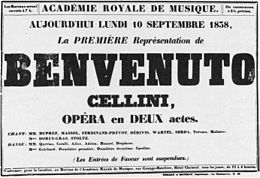| Benvenuto Cellini | |
|---|---|
| Opera semiseria by Hector Berlioz | |
 Poster for the premiere | |
| Librettist | |
| Language | French |
| Based on | Benvenuto Cellini |
| Premiere | 10 September 1838 Salle Le Peletier, Paris |
Benvenuto Cellini is an opera semiseria in four tableaux (spread across two or three acts[1]) by Hector Berlioz, his first full-length work for the stage. Premiered at the Académie Royale de Musique (Salle Le Peletier) on 10 September 1838, it is a setting of a libretto by Léon de Wailly and Henri Auguste Barbier, who invented most of the plot inspired by the memoirs of the Florentine sculptor Benvenuto Cellini. The opera is technically challenging[2] and was until the 21st century rarely performed.[3][4][5] But its overture sometimes features in orchestral concerts, as does the concert overture Le carnaval romain which Berlioz composed from material in the opera.
- ^ Originally, the opera had two acts; in the revised, Weimar version this was changed to three; in contemporary productions the first two acts of that version are generally merged without intermission.
- ^ Kunde, Gregory; Linda Wojciechowski Kunde (2003). "Benvenuto Cellini in Zurich: A Rehearsal Diary". The Opera Quarterly. 19 (3): 417–426. doi:10.1093/oq/19.3.417.
- ^ Andrew Clements (2003-08-19). "Benvenuto Cellini: Prom 39, Royal Albert Hall, London (2003)". The Guardian. Retrieved 2007-06-08.
- ^ Donal Henahan (1983-05-10). "Berlioz's Cellini". The New York Times. Retrieved 2007-09-07.
- ^ Anthony Tommasini (2003-12-06). "Opera Review: Benvenuto Cellini at the Met". The New York Times. Retrieved 2008-05-10.